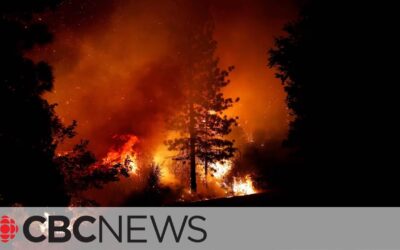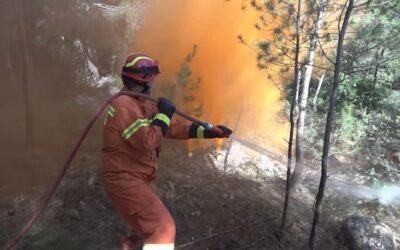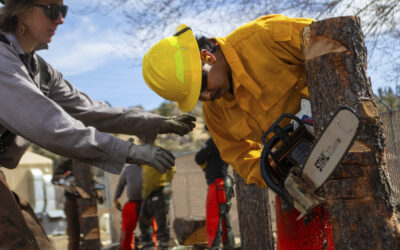John Aguilar
The Denver Post
(TNS)
Feb. 8—December’s Marshall fire spared the Rocky Flats National Wildlife Refuge, an expanse of grasslands between Superior and Arvada that, had winds shifted, could have provided 6,200 acres of additional drought-stricken fuel to the destructive blaze.
What if a fire like the one that burned down more than 1,000 homes in Boulder County on Dec. 30 had turned suddenly south and raced across the refuge, where for 40 years triggers for nuclear warheads were assembled as part of the country’s Cold War standoff with the Soviet Union?
That was the topic of discussion Monday at a Rocky Flats Stewardship Council meeting, where elected officials from communities surrounding the refuge came together to talk about the potential hazards — including the release of deadly plutonium from the soil into the air — that could arise from an event like the Marshall fire on refuge land.
” Rocky (Flats) has burned before, Rocky will burn again in the future,” the council’s executive director, Dave Abelson, said. “Those are just facts. You can’t stop wildfire, as we all know.”
In fact, the refuge has experienced a dozen fires since 2000, according to the U.S. Fish and Wildlife Service, ranging in size from less than an acre in 2020 to 852 acres in 2006.
“Fire is not uncommon,” said Dave Lucas, refuge manager for Rocky Flats. “We basically have one wildfire every year. That is a reality.”
For those who believe the Rocky Flats National Wildlife Refuge, which opened to the public in 2018, isn’t safe due to residual contamination from Cold War bomb-making activity, the Marshall fire was a jolting wake-up call that more needs to be done at the site to protect people in the face of a natural disaster.
“This is really inappropriate to have people on the site,” long-time Rocky Flats activist Lynn Segal said during the meeting Monday. “I mean this came close.”
But Andy Keim, site manager for Rocky Flats with the U.S. Department of Energy, said wildfire danger modeling completed when the nuclear weapons plant was razed and cleaned up more than a decade ago shows little need for concern.
Keim’s agency oversees the 1,300-acre “central operable unit” at the refuge, where the plant was located and which remains a Superfund site that is off-limits to the public.
“The remaining infrastructure — buildings, slabs and basements — and subsurface soils with residual radiological contamination are buried beneath at least 3 feet of clean soil,” Keim told the stewardship council Monday. “And a wildfire poses no real potential threat to these buried materials because the soil acts as a physical barrier separating material from the ground surface where the fire is, plus limiting heat transfer.”
Unlike forest fires, he said grassland fires “typically move quickly and burn cool.” A risk assessment done on fire danger at Rocky Flats concluded that “residual surface soil contamination did not pose a significant risk,” he said.
“And also, modeled firefighter exposures to smoke indicated that radiological hazards of a grassfire at Rocky Flats are negligible,” Keim said.
But Giselle Herzfeld with the Rocky Mountain Peace and Justice Center in Boulder, said there is every reason to worry about fire at the refuge.
“If there were a fire at Rocky Flats, it is very likely that the radioactive contamination would become airborne and put those living nearby and downwind at risk of inhaling airborne plutonium particles and other radionuclides,” she said. “This risk is heightened by particularly high winds at the site.”
She noted that winds on the day of the Marshall fire reached speeds of 115 mph at Rocky Flats.
“If a plutonium particle is inhaled, that particle is likely to remain in a person’s lungs permanently,” Herzfeld said. “In that time it will constantly bombard surrounding cells with radiation, putting that person at risk of developing a lung tumor.”
Rocky Flats generated headlines in 2019 when an elevated sample of plutonium was found on refuge property near Indiana Street. But so far that sample has proven to be an outlier, with dozens of other soil samples taken on the refuge showing plutonium levels well within government-defined acceptable risk thresholds for the substance.
But Boulder County Commissioner Claire Levy on Monday strongly urged refuge officials to conduct air monitoring after a fire to ensure that no contaminants had been released into the air.
“Models are models — sometimes real-life conditions show otherwise,” she said. “After a fire, what would be done to not just assure the public but actually determine whether the air and ash are safe?”
Arvada City Councilman Randy Moorman expressed similar concerns.
“Every fire is different and so I feel like monitoring several fires in the past isn’t going to tell us what future fires are going to do and what that’s going to be like,” he said. “I think especially from the public interest perspective we really need to have monitoring happening after every fire because that’s the greatest concern — what is happening in our air after that fire?”
Fire has been contentious before at Rocky Flats. In 2015, public outcry over a proposed prescribed burn at Rocky Flats — and concerns about air contamination — led to it being scrapped. Lucas said there hasn’t been a prescribed burn at the site since 2000 and “none are planned.”
Lucas said the refuge is serviced by several fire protection districts and departments, including Mountain View, Coal Creek and Arvada Fire. But a couple of immediate measures would be taken in response to the Marshall fire.
Fish and Wildlife personnel will bump up mowing the southern boundary of Rocky Flats, where the refuge abuts hundreds of houses in Arvada’s Candelas neighborhood, to twice a year from once annually. The buffer would be about 40 feet wide, Lucas said.
And the agency would stage one of its Type 6 wildland fire engines, known as a brush truck, year round at Rocky Flats rather than just during summer months.
“This area has changed — you have 684 homes that line the southern boundary that didn’t exist a handful of years ago, so planning has changed,” Lucas said.
___
(c)2022 The Denver Post
Visit The Denver Post at www.denverpost.com
Distributed by Tribune Content Agency, LLC.




